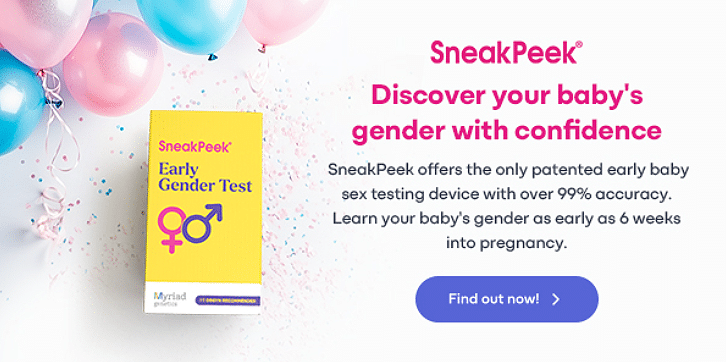Published on June 11th, 2025
Check out SneakPeek Gender Test to find out your baby’s gender as early as 6 weeks with over 99% accuracy!

Back in the not-so-distant past, expecting parents hauled themselves and their beautiful bump to the doctor’s office to find out one of the most anticipated traits of their future child: their sex.
But if you’ve recently spent any time researching early DNA testing, you know that today, the gender determination process looks a little bit different—and a lot more convenient. But how long does a gender blood test take?
Gender blood tests are a type of non-invasive prenatal testing (NIPT)—a family of tests that screen a pregnant person’s blood for fetal DNA. While NIPT tests are most typically used to look for chromosomal or genetic abnormalities, they’re also available for nearly effortless home use: introducing expecting parents to their future child’s sex.
How long the NIPT test results take depends on your provider and several other procedural contingencies. Learning more about how sex testing works can help you decide which company to purchase from and whether this form of genetic testing is right for you.
NIPT Tests: What They Are and How They Work
So, what is an NIPT test, exactly? NIPTs were first introduced around 2011, but they didn’t hit the commercial market until more recently. With the advancement of technology and shipping distribution networks, NIPTs for at-home prenatal sex prediction are now available so that parents can learn their baby’s predicted sex without leaving the comfort of their home.
In the days before NIPTs and at-home testing, mid-pregnancy ultrasounds known as anatomy scans were the usual way to predict a baby’s sex. Originally, these were conducted well into the second trimester, typically between 18 and 22 weeks.
In addition to sex, healthcare providers used the following two tests to detect chromosomal abnormalities before NIPTs were available:
- Amniocentesis – In this procedure, amniotic fluid is taken from the amniotic sac using a needle through the abdomen. Amniocentesis is typically conducted around 16 weeks of pregnancy. Because the procedure is slightly more invasive, it carries a very small risk of infection that could lead to miscarriage.
- Chorionic villus sampling (CVS) – In this procedure, a sample is taken from the chorionic villi (tiny outgrowths in the placenta). It can be conducted slightly earlier than amniocentesis (between 10 to 12 weeks) with results typically available between 1 and 2 weeks. However, there is a slight risk of miscarriage.
At-home sex blood tests are in a class of their own because they’re non-invasive, meaning testing can be carried out in the privacy of one’s own home. Moreover, they pose no risk to the fetus, or the person carrying it.
At-home tests specifically for sex are also very straightforward to use by people who aren’t trained in drawing blood. Typically, the process works like this:
#1 Point of Purchase
First, the customer purchases the test either online or at a local retailer or clinic. If ordered online, a sample retrieval kit is then sent to their home.
#2 Collecting the Sample
Following instructions provided by the testing company, the user collects a blood sample. So, how does the SneakPeek Early Gender Test work in particular? At SneakPeek, we provide two methods of sample retrieval:
- Lancets, which can be used like a typical finger prick test
- Our patented Snap device, which can be used on the arm
With either test, it’s important to sterilize the sample area with alcohol to ensure cleanliness and safety before collecting the sample.
To keep everything hygienic and simple, SneakPeek provides several preparatory materials depending on your kit of choice. These could include:
- Gauze
- Alcohol prep pad (to sterilize the area)
- Exfoliating brush
- Fingernail brush
- Warming pack
- Bandages
#3 Mailing in the Sample
Next, the user packs up their sample, following their provider’s instructions to ensure the sample’s safety. Proper packaging is crucial for ensuring the sample’s security and preventing delays. The user ships it to the lab for processing and analysis.
#4 Lab Screening
Certified lab professionals review the sample, looking for DNA markers that indicate the fetus’ sex. At SneakPeek, technicians look for signs of male DNA (a Y chromosome) in the blood sample provided. If they find a Y chromosome, the baby’s sex is predicted to be male. If there is no Y chromosome present, the baby’s sex is predicted to be female.
#5 Receipt of Results
Depending on the provider’s timeline, users typically receive their results within a few days to a week or so of shipment. Sometimes, providers offer fast-track services—like priority processing at the lab, or expedited shipping—for a fee.
Today, most results are efficiently delivered via email, through a provider web portal, or both.
When do I get my results back?
Ultimately, it depends.
At SneakPeek, users often receive their test results soon after the sample gets to the lab. Samples are typically delivered in the morning, between Mondays and Saturdays. Once they’ve landed, expecting parents will receive a notification indicating their results have made it to the lab facility.
Other companies may have different genetic testing procedures, and therefore different timing. The following key factors play a major role in determining when you’ll receive your results:
- Shipping times – Shipping timelines are one of the most decisive factors in results times, though users have some control in this area. Although at-home NIPT testing costs more when you opt for faster shipping options, expedited shipping may help avoid delays, while standard mail can make for slower response times. If you live in a more remote location, it could take longer to get your results.
- Sample quality – If a sample is found to be contaminated, faulty, or otherwise compromised, it may need to be reprocessed. In a worst-case scenario, it may need to be taken again and shipped out again.
- Lab processing speeds – Every lab is different and may adhere to its own procedures and processing timelines.
Benefits of At-Home Blood Testing
At-home testing reveals a baby’s sex far earlier into pregnancy—with the SneakPeek test, as early as 6 weeks following conception.
If you’re on the fence about whether an at-home blood test is right for you, knowing the advantages can help you make your decision.
#1 Early Timing
With an at-home blood test, you could learn your baby’s sex as early as 6 weeks into your pregnancy, which can be more than 8 weeks sooner than a gender reveal ultrasound.
Not only does this beat out the traditional ultrasound timeline, but it also gives you extra time to plan for your little one’s arrival. This can be especially advantageous when it comes to:
- Thinking about baby names
- Choosing nursery themes
- Purchasing, thrifting, or borrowing baby clothes
- Preparing emotionally
- Letting your friends, family, and loved ones know
#2 Convenience
Although ultrasound tests can now reveal sex earlier than the mid-second trimester, DNA testing can get more accurate results even earlier than an anatomy scan.
Plus, many people find it a hassle to schedule a visit and head to their healthcare provider’s office for information that can be readily disclosed via home testing.
#3 Comfort
At-home tests are non-invasive. Most people who use them would say they enable a degree of comfort they can’t get at an ultrasound appointment. Because the sample collection procedures are simple and safe, home testing is considered a low-risk, low-maintenance option compared to ultrasounds.
#4 Accuracy
DNA testing is a remarkably accurate testing medium when it comes to determining gender. This is particularly true if an at-home test is taken after 10 weeks of pregnancy when NIPTs only get sex wrong 1% of the time.
The SneakPeek Early Gender Test boasts an accuracy rating of over 99% as early as 6 weeks into a pregnancy.
What to Do After Receiving Your Test Results
That’s entirely up to you!
Depending on how it feels to get your results, you may want to keep them private for a while or immediately share the news with loved ones. The information you acquire from early testing simply empowers you with more information about what life might look like as a future parent.
Remember, learning your baby’s sex is just one part of the package. Keeping up with your prenatal appointments, getting your questions answered, and maintaining a proactive attitude over these next 9 months are key to discovering not just who your baby will be, but who you’re becoming as a parent.
Can I Take a Gender Blood Test If I’m Pregnant with Multiples?
The SneakPeek Early Gender Test is designed for singleton pregnancies, but it can still provide some insights for pregnancies with multiples.
SneakPeek analyzes fetal DNA found in the mother’s blood sample, specifically looking for the presence of male DNA (the Y chromosome):
- Identical twins: If male DNA is detected, both babies are boys. If no male DNA is found, both are girls.
- Fraternal twins (or more): If male DNA is present, at least one baby is a boy—but the test cannot determine the sex of the second baby (or additional babies).
Because of these limitations, SneakPeek results for multiples cannot confirm the sex of each baby individually. If you’re expecting twins or more, check out our guide to gender testing for twins for a more detailed explanation of how results are interpreted in multiple pregnancies.
Get Answers Sooner and From the Comfort of Home with the SneakPeek® Test
If you’re sold on early gender testing, be sure to pick a trustworthy provider with a track record of satisfied parents, like SneakPeek. With our simple-to-use, at-home Early Gender Test, over 1 million parents have already discovered their baby’s sex as early as 6 weeks into gestation with over 99% clinically proven accuracy.
Learn why the SneakPeek test is the #1 OBGYN-recommended at-home early gender test and find more tips for every stage of your pregnancy journey, from your preconception checkup to your gender reveal, and beyond.
Editorial Policy
At SneakPeek, our commitment is to provide accurate, up-to-date, and reliable information to empower our readers. Our content is thoroughly researched, reviewed by medical experts, and fact-checked to ensure its credibility. We prioritize the well-being and education of our readers, and our editorial policy adheres to the highest standards of integrity and accuracy in all our articles.
This post has been reviewed for accuracy by the following medical professional:
Dr. Stitt is a board-certified OB/GYN with over 20 years of experience providing compassionate care to women throughout every stage of pregnancy and childbirth. She is currently the medical director for a large group practice in Annapolis, Maryland and is actively involved in training both OB/GYN residents and medical students. Dedicated to patient education and empowerment, Dr. Stitt is passionate about helping women make informed decisions about their health, from prenatal care to postpartum recovery. Known for a warm and supportive approach, Dr. Stitt strives to create a positive and reassuring experience for expectant mothers, ensuring they feel confident and well-prepared for the journey of motherhood.
Sources:
- Cleveland Clinic. NIPT Test. https://my.clevelandclinic.org/health/diagnostics/21050-nipt-test#results-and-follow-up
- National Library of Medicine. Non-Invasive Prenatal Testing (NIPT): Reliability, Challenges, and Future Directions. https://pmc.ncbi.nlm.nih.gov/articles/PMC10417786/
- National Library of Medicine. Noninvasive Prenatal Testing: The Future Is Now. https://pmc.ncbi.nlm.nih.gov/articles/PMC3893900/
- UT Southwestern Medical Center. Amniocentesis and CVS: FAQs about the prenatal diagnostic duo. https://utswmed.org/medblog/cvs-amniocentesis-faqs/
- Parents. How to Determine a Baby’s Gender from an Ultrasound. https://www.parents.com/pregnancy/stages/ultrasound/ultrasound-accuracy-is-it-a-boy-or-a-girl/
- Cleveland Clinic. Pregnancy. https://my.clevelandclinic.org/health/articles/pregnancy
- The Bump. Your Complete Guide to Pregnancy Ultrasounds. https://www.thebump.com/a/pregnancy-ultrasound-guidelines
- Cleveland Clinic. Pregnant? Here’s How Often You’ll Likely See Your Doctor. https://health.clevelandclinic.org/prenatal-appointment-schedule
- The Bump. Boy or Girl: What’s the Chance Baby’s Gender Test Is Wrong? https://www.thebump.com/a/ultrasound-wrong-gender








